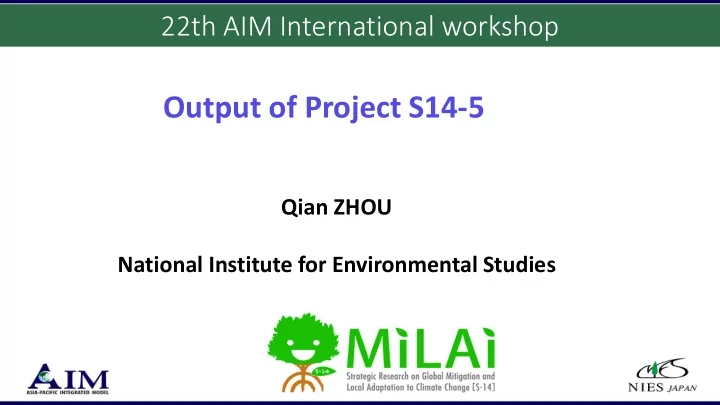

22th AIM International workshop Output of Project S14-5 Qian ZHOU National Institute for Environmental Studies
What’s Project S14?
What’s Project S14? S14: Professor Oki Taikan The University of Tokyo S14-5: Section head: Dr. Hijioka Yasuaki S14-5(2) Dr. Hanasaki Naota Dr. Qian ZHOU
What did w we d do in P n Project S t S14 14-5(2)? Mission: Establishing theoretical and technical foundation for coupling Global Hydrology model H08 and CGE model PI: Dr. Hanasaki Naota Dr. Zhou Qian Focus: Water constraints on global hydropower and thermoelectric supply capability under climate change
Background: hydropower supply • Currently, hydropower is a dominant renewable resource due to its low cost and low greenhouse gas (GHG) emissions (IEA, 2012). • However, hydropower potential is effected by climate change
Background: thermal power supply Climate change Cooling water shortage Thermal power plant shut down 5
How climate change constraints hydropower and thermal power supply capability through water ? 2017/12/1 6
Hydropower 2 Hydropower 1 Hydropower 1 Thermal power 1 Thermal power 2 and 3 On the way…... Zhou et al. 201? Zhou et al. 2016 Zhou et al. 2017 2017/12/1 7 Under preparation
Hydropower 1 Model-Based Analysis of Impact of Climate change and Mitigation on Hydropower Qian ZHOU, Naota HANASAKI, Shinichiro FUJIMORI, Yoshimitsu MASAKI and Yasuaki HIJIOKA National Institute for Environmental Studies
Research Questions This paper aims to address following research questions: • What is the state-of-the-art knowledge on the impact of climate change on hydropower? • What are the potential key interactions of combining physical models and economic models in terms of hydropower in global and regional scales? • How significant such interactions are? 2017/12/1 9
Method • Global Hydrology model • AIM/CGE model 2017/12/1 Zhou et al. 2016 10
IAM model Fix the Results hydropower supply capability Physical Economic model model Supply potential is variable Electricity Generation increase fast 2017/12/1 11 Zhou et al. 2016
Decreased Results supply potential Global hydropower supply potential is variable Increased Zhou et al. 2016
Climate change impact on hydropower potential Results Mitigation impact on hydropower generation Zhou et al. 2016
Questions Is climate change impact on hydropower potential is negligible? How to quantify economy consequence of hydropower potential change? 2017/12/1 14
Hydropower 2 Hydropower 1 Thermal power 1 Thermal power 2 and 3 On the way…... Zhou et al. 201? Zhou et al. 2016 Zhou et al. 2017 2017/12/1 15 Under preparation
Hydropower 2 Economic consequences of global climate change and mitigation on future hydropower Qian ZHOU, Naota HANASAKI, Shinichiro FUJIMORI, Yoshimitsu MASAKI and Yasuaki HIJIOKA
Methodology How to quantify economy consequence of hydropower potential change?
Results Hydropower Generation change no Mitigation Mitigation Figure 4. Magnitude of hydropower generation changes
Results Why GDP changes is different in these regions? no Mitigation Mitigation Figure 4. Magnitude of GDP changes
Results GCMs uncertainty analysis for GDP no Mitigation Mitigation Figure 9 . Magnitude of GDP changes due to individual and ensemble GCM based MAHG shocks
Hydropower 2 Hydropower 1 Thermal power 1 Thermal power 1 Thermal power 2 and 3 On the way…... Zhou et al. 201? Zhou et al. 2016 Zhou et al. 2017 2017/12/1 21 Under preparation
Thermal power 1 An Analysis on Hypothetical Shocks Representing Cooling Water Shortage Using a Computable General Equilibrium Model Qian ZHOU, Naota Hanasaki, Jun’ya TAKAKURA, Shinichiro FUJIMORI, Kiyoshi TAKAHASHI and Yasuaki HIJIOKA National Institute for Environmental Studies 22
Background • In 2007, nuclear and coal-fired plants in the Tennessee Valley Authority system were forced to shut down or curtail operations because intake water exceeded 90 F (32.2 ° C) for 24 hours • In 2003, France lost the electricity production of 7% to 15% of nuclear capacity for 5 weeks (DOE, 2012) 23
Research Question • What is the socio-economic consequence of giving a certain intensity of shock representing the shortage of cooling water in thermal power sectors under the framework of a computable general equilibrium model? • How the shock in thermal power sectors propagates into the global economy. 24
Method: Framework - How to numerate cooling water shortage for CGE input data? - How to connect cooling water shortage with CGE model? AIM/CGE model Hypothetical Shocks: 4 days/year power plants shut down: 4/365≈1% reduction
Result: How were electricity and GDP changed? c a b d Fig. 3 (a) Thermal power change compared with baseline in 2050 in ARAY scenario. (b) Mean difference in electricity generation (EG) from the baseline (between 2005 and 2100). (c) The rate of thermal electricity production to total electricity production in 2005. 26 (d) GDP change compared with baseline in 2050 in ARAY scenario
Hydropower 2 Hydropower 1 Thermal power 1 Thermal power 2 and 3 Thermal power 2 and 3 On the way…... Zhou et al. 201? Zhou et al. 2016 Zhou et al. 2017 2017/12/1 27 Under preparation
Thermal power 2 and 3 Topic 1: Global thermal power usable capacity reduction from cooling water consumption shortage attributable to climate change Topic 2: Economic consequences of cooling water shortage impact on thermoelectric supply capability under climate change
impact the global thermoelectric usable capacity? Results • How climate change • 5 GCMs • RCP2.6 and RCP8.5 2017/12/1 29
USA Data: 2005-2100 — RCP2.6 — RCP8.5 — RCP2.6 — RCP8.5 GC GCM: M MIR IROC Results GDP change (%) Usable capacity change (%)
Summary Climate change impact on hydropower and • thermoelectric potential should not be negligible in IAM 2017/12/1 31
Acknowledgements The Environment Research and Technology Development • Fund (S-14) of the Ministry of the Environment, Japan, supported this work.
22th AIM International workshop Thank you very much for your attention! zhou.qian@nies.go.jp 2017/12/1 33
Recommend
More recommend